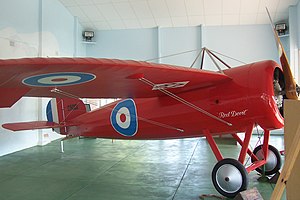Bristol M.1
| Bristol M.1 | |
|---|---|
 |
|
| The only surviving Bristol monoplane on display at Minlaton, South Australia, 2005 | |
| Role | Fighter |
| Manufacturer | Bristol Aeroplane Company |
| Designer | Frank Barnwell |
| First flight | 14 July 1916 |
| Introduction | 1917 |
| Primary users |
Royal Flying Corps Chile |
| Number built | 130 |
The Bristol M.1 Monoplane Scout was a British monoplane fighter of the First World War.
In 1916, Frank Barnwell, chief designer of Bristol Aeroplane Company, realising that the performance of existing fighter aircraft was inadequate, designed a new single-seat tractor monoplane fighter as a private venture, the Bristol M.1.
The first prototype, the M.1A made its maiden flight on 14 July 1916. It was of conventional wood and fabric construction, with a carefully streamlined circular cross-section fuselage. The wing was shoulder mounted and was braced with flying wires running from the wing to the lower fuselage and landing wires from the wings to a cabane made of two semi-circular steel tube hoops positioned over the pilot's cockpit. A 110 horsepower (82 kW) Clerget rotary engine drove a two-bladed propeller fitted with a large hemispherical spinner to reduce drag. It was purchased by the War Office for evaluation, and demonstrated impressive performance during official testing, reaching a speed of 128 miles per hour (206 km/h) and climbing to 10,000 feet (3,000 m) in 8 minutes 30 seconds, although the forward and downward view was criticised by test pilots.
The War Office ordered four modified aircraft, designated M.1B, in October 1916. These differed from the first prototype in having a more conventional cabane consisting of a pyramid of four straight steel struts, a large clear-view cut-out panel in the starboard wing root to give improved view for landing and a single .303 in (7.7 mm) Vickers machine gun mounted on the port wing root.
Despite excellent performance - it had a maximum speed some 30-50 mph (50–80 km/h) higher than any of the contemporary German Fokker Eindecker and French Morane-Saulnier N monoplanes - it was rejected by the Air Ministry for service on the Western Front, ostensibly because its landing speed of 49 mph was considered too high for small French airfields, but more likely because of a widespread belief that monoplane aircraft were inherently unsafe in combat. The RFC had imposed a ban on monoplanes after the crash of one of the Bristol-Coanda Monoplanes on 10 September 1912, and despite the subsequent 1913 Monoplane Committee clearing the design type there persisted a deep-rooted suspicion of monoplanes. This suspicion may also have been re-inforced by the RFC's underwhelming experience with various Morane-Saulnier monoplanes, especially the Morane-Saulnier N, which was also criticised for its high landing speed.
...
Wikipedia
